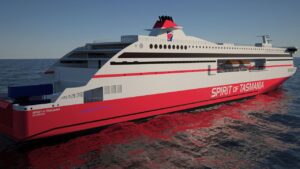
Assessing the Fiscal Health and Future Viability of TTline
The TTLine annual financials were lodged with ASIC 5 weeks ago without fanfare. Often, and more usually, they are lodged late October after tabling of the full Annual Return in Parliament. I hope this is a practice that is continued and other State Owned Companies (SOCs) do the same. Government Business Enterprises (GBEs) like Hydro, Sustainable Timbers and MAIB could likewise publish their annual financial statements on their websites when signed off by the Auditor General, as demonstrated by TTLine can be done in a more open and transparent manner by. This allows a more timely consideration and more opportunities for timely scrutiny in Parliament. After all these businesses are owned by the people of Tasmania who deserve to be informed on a timely basis.
Introduction
TTLine’s 2024/25 financial statements paint a sobering picture of an organisation under significant fiscal stress. Static revenue, ballooning costs, and mounting debt have collectively eroded TTLine’s financial resilience, raising serious questions about its long-term solvency and operational sustainability. This critical appraisal synthesises initial observations and a detailed financial summary to evaluate the company’s position and outlook.
Revenue Stagnation and Cost Escalation
TTLine’s revenue for 2025 remained virtually unchanged at $309.6 million, only marginally higher than the $307.5 million recorded in 2024. This stagnation is particularly concerning given the company’s capital-intensive operations and rising expense base. Passenger services accounted for 60% of income and freight the remaining 40%, but neither segment delivered meaningful growth. Meanwhile, total expenses climbed to $333.2 million (from $326.2 million), largely driven by increases in employee and operating costs. The resulting loss before tax worsened to $23.5 million, up from $18.7 million the previous year.
The static revenue, against a backdrop of rising operating costs, signals a business model under pressure. Without top-line growth, TTLine’s ability to absorb cost increases, service debt, and invest in asset renewal is severely constrained.
Debt, Interest, and Capitalisation Practices
TTLine’s capital structure is dominated by substantial borrowings, primarily to finance the replacement of the current aging vessels and new infrastructure. The company paid $48 million in interest to Tas Corp on a hefty $865 million loan at an interest rate of 6.63%. Importantly, this interest was not recognised as an expense in the profit and loss statement but was instead capitalised as the assets are still classified as ‘work in progress’ (WIP). While this accounting treatment is standard for assets under construction, it temporarily masks the true extent of interest costs and their impact on profitability.
Once the new assets become operational and interest can no longer be capitalised, TTLine’s profit and loss statement will bear the full weight of these finance costs. This will place further strain on already negative earnings and could push the company into deeper losses, especially if revenue growth continues to lag.
EBITDA, Lease Costs, and Cash Flow Dynamics
A critical issue in the 2025 results is the transformation of TTLine’s EBITDA profile, the cash earnings available to pay interest, make loan payments and fund capex amounts. When depreciation, amortisation, finance costs, and asset revaluation are stripped out, and the Geelong Port lease fees included ($30.3 million in 2025, $29.0 in 2024), EBITDA was negative at -$4.2 million, compared to a positive $9.5 million the previous year.
This negative EBITDA means TTLine lacked the cash flow to service interest on its borrowings after lease payments. Most interest and depreciation in the P&L related to the Geelong Port lease rather than traditional loan or asset depreciation. To cover interest, TTLine was forced to borrow additional funds, deepening its debt spiral, borrowing from TASCORP to pay TASCORP.
Working Capital Erosion and Liquidity Risks
TTLine’s working capital position deteriorated markedly in 2025. Current assets fell to $35.5 million (from $74.7 million), while current liabilities ballooned to $182.1 million (from $165.7 million), worsening the current asset-to-liability ratio to an alarming 5:1. Cash reserves plummeted from $40 million to $7.4 million, and the company drew a $28 million overdraft – a facility previously unused. Trade creditors rose sharply, likely reflecting deferred payments for operations and capital expenditure.
This acute liquidity stress is further highlighted by a rare scenario where liabilities due within 12 months are five times the assets available to cover them. Such a ratio is a classic sign of financial distress and would have necessitated the recent increase in borrowing limits and the provision of a government guarantee, merely to ensure TTLine’s short-term survival as a going concern.
Work in Progress and Asset Valuation Concerns
As of 30/06/2025, TTLine’s WIP account stood at $1.238 billion, incorporating capitalised interest, new ferries, and infrastructure projects like Berth 3 at Devonport. With $220 million in outstanding capex commitments and the likelihood of further commitments, the WIP account may soon exceed the fair value of the assets, potentially triggering impairment charges. This further threatens the company’s balance sheet integrity.
Debt Management and Future Solvency
TTLine’s loan facilities have expanded significantly, with a limit raised to $1.39 billion (plus a $45 million working capital facility), of which an expected $1.296 billion will be drawn. Peak debt may be reduced by approximately $170 million following the sale of existing vessels, but this is contingent on successful asset sales in a potentially challenging market. The annual interest burden is projected at around $60-70 million, raising legitimate doubts about TTLine’s capacity to service its debt without either fresh equity or a step-change in earnings.
Conclusion: A Precarious Path Forward
TTLine’s 2024/25 financials reveal a company at a crossroads. With revenue flatlining, costs climbing, and debt ballooning, the business is being sustained by ever-increasing borrowings and government support. The negative EBITDA after lease payments, rapid depletion of cash, and worsening working capital point to a business model that is unsustainable in its current form.
While the completion of new assets and a possible reduction in peak debt through asset sales may provide some relief, the fundamental challenge remains: TTLine must achieve a positive, sustainable EBITDA to meet its obligations. Until then, the company’s long-term solvency is far from assured, and its financial stability remains highly vulnerable to any adverse changes in market or operating conditions.

